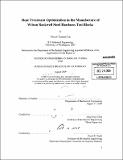Heat treatment optimization in the manufacture of Wilson Rockwell steel hardness test blocks
Author(s)
Tan, Vincent Tandean
DownloadFull printable version (7.728Mb)
Other Contributors
Massachusetts Institute of Technology. Dept. of Mechanical Engineering.
Advisor
Jung Hoon Chun.
Terms of use
Metadata
Show full item recordAbstract
The heat-treatment process in the manufacture of Wilson Rockwell steel hardness test blocks often produces parts which are inconsistent in the mean hardness and hardness uniformity. In this thesis, the sources of variation in the mean hardness and hardness uniformity of the test blocks are identified by means of metallurgical study and Design of Experiments methodology. The uniformity of temperature distribution within the heating chamber and the effect of temperature and material composition on the final microstructure of the steel are analyzed. The hardness measurements and preparation of metallographic specimens follow the standards defined by the American Society for Testing and Materials (ASTM). Several control factors including soak temperature, soak time and location within the heating furnace are included in the Design of Experiment. The effects and interactions of control factors are studied using analysis of variance (ANOVA) techniques. Response Surface Methodology (RSM) was used to minimize the hardness variation on the interaction of the control factors. The heat-treatment experiment indicated that non-uniform temperature distribution within the heating chamber resulted in test blocks of different mean hardness in a batch run. The experiment also demonstrated that hardening temperatures below the homogeneous austenite formation temperature resulted in a large hardness variation. Several control factors and interaction between the factors that are significant on the mean hardness and hardness variation are identified. And finally, recommendations of control factor settings that minimize the hardness variation are presented in this thesis.
Description
Thesis (M. Eng.)--Massachusetts Institute of Technology, Dept. of Mechanical Engineering, 2009. Cataloged from PDF version of thesis. Includes bibliographical references (p. 84-85).
Date issued
2009Department
Massachusetts Institute of Technology. Department of Mechanical EngineeringPublisher
Massachusetts Institute of Technology
Keywords
Mechanical Engineering.